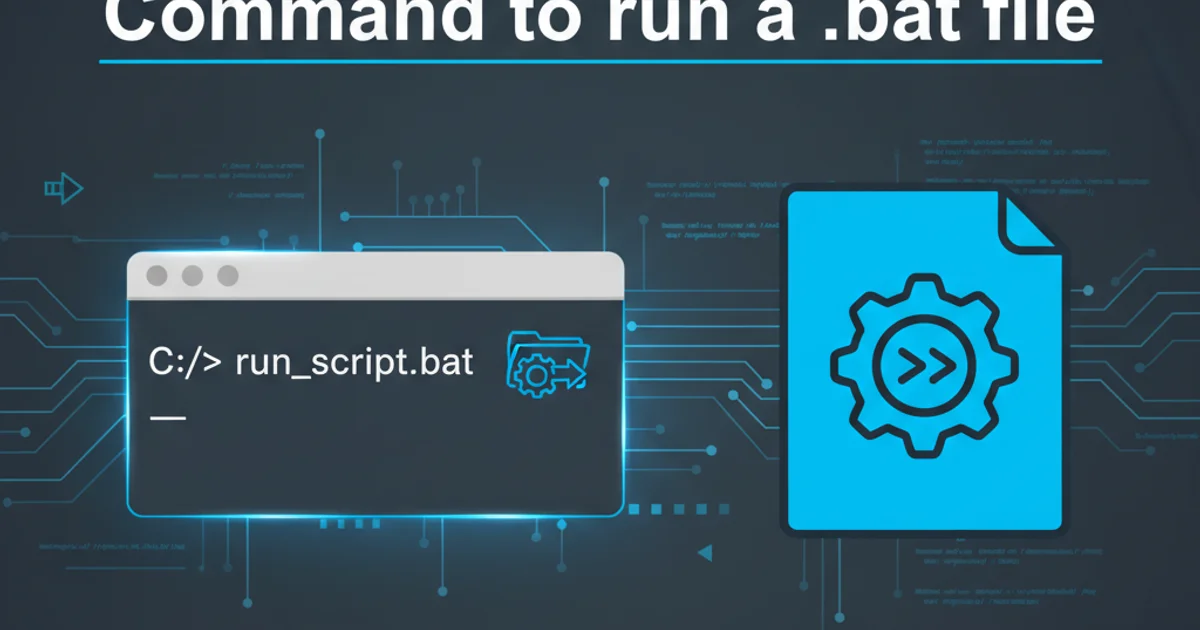Command to run a .bat file
Categories:
Executing Batch Files: A Comprehensive Guide for Windows Users

Learn the various methods to run .bat files on Windows, from the command prompt to graphical interfaces, and understand best practices for execution.
Batch files (.bat or .cmd) are simple script files that contain a series of commands executed by the Windows command interpreter. They are commonly used for automating repetitive tasks, running system utilities, or launching applications. This article will guide you through different ways to execute these files, explain common issues, and provide best practices.
Running Batch Files from the Command Prompt
The most fundamental way to execute a batch file is directly from the Command Prompt. This method offers the most control and is essential for scripting and automation. You can either navigate to the directory containing the batch file or specify its full path.
REM Navigate to the directory first
cd C:\MyScripts
MyBatchFile.bat
REM Or, run directly using the full path
C:\MyScripts\MyBatchFile.bat
Executing a batch file from the Command Prompt
PATH environment variable, you can run it from any location by simply typing its name (e.g., MyBatchFile.bat).Executing with the CALL Command
When you want to run one batch file from within another batch file, the CALL command is crucial. Without CALL, the first batch file would terminate after launching the second one. CALL ensures that control returns to the original script once the called script finishes.
REM main_script.bat
@echo off
echo Starting main script...
CALL sub_script.bat
echo Main script continuing after sub-script.
pause
Using CALL to execute a batch file from another batch file
flowchart TD
A[Start Main Script] --> B{"Call Sub Script?"}
B -- Yes --> C[Execute Sub Script]
C --> D[Return to Main Script]
D --> E[Continue Main Script]
E --> F[End Main Script]Flow of execution when using the CALL command
Running with START for Asynchronous Execution
The START command is used to run programs or commands in a new window, or to run them asynchronously without waiting for them to complete. This is particularly useful when you want to launch a batch file (or any executable) and immediately continue with the current script or command prompt session.
REM Launch a batch file in a new window and continue immediately
START "My Batch Process" C:\MyScripts\AnotherBatchFile.bat
echo This message appears immediately after launching the batch file.
Using START to run a batch file asynchronously
START without the /WAIT option, as it can lead to race conditions or unexpected behavior if subsequent commands depend on the launched process completing.Graphical Execution and Context Menu
For non-developers, the simplest way to run a batch file is often by double-clicking it in File Explorer. You can also right-click and choose 'Run as administrator' for scripts that require elevated privileges. Creating shortcuts can further streamline this process.
1. Double-Click in File Explorer
Navigate to the batch file's location in File Explorer and simply double-click it. A command prompt window will briefly appear, execute the commands, and then close (unless PAUSE is used).
2. Run as Administrator
If the batch file needs administrative rights (e.g., to modify system files or registry), right-click the file and select 'Run as administrator'. You will be prompted by User Account Control (UAC).
3. Create a Desktop Shortcut
Right-click the batch file, select 'Send to' -> 'Desktop (create shortcut)'. You can then double-click the shortcut to run the script. You can also right-click the shortcut, go to 'Properties', and set it to 'Run as administrator' under the 'Advanced...' button in the 'Shortcut' tab.